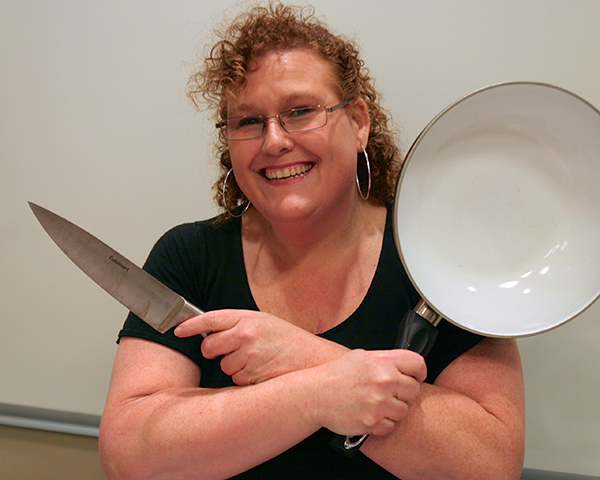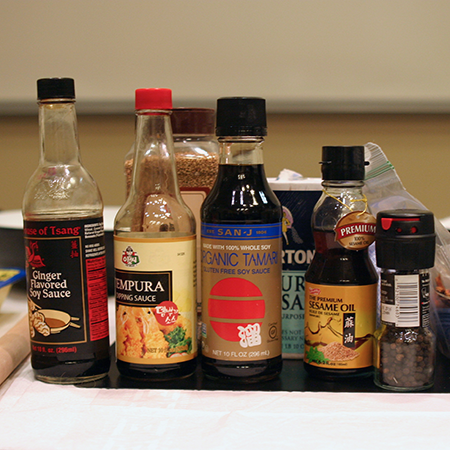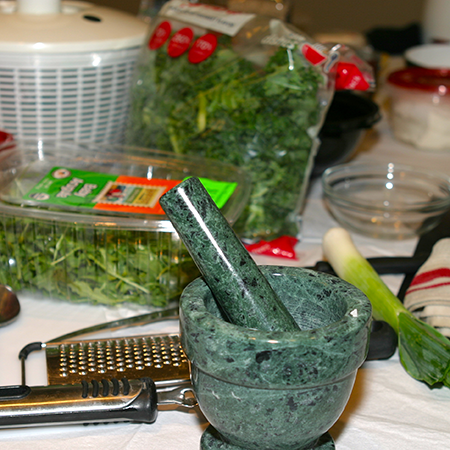Recently, Christina Mazzella (IT F&A) did a demonstration in the 1762 building for making Vegetable Dumplings (aka potstickers). This demo was part of the OIT vs Emory College Weight-loss Challenge. Following her demo, attendees tasted plenty of delicious vegetarian samples. Sandra Harrison (IT F&A) helped Christina with the vegetable chopping.
Vegetable Dumplings Recipe
- 1 cup lightly packed, coarsely chopped Kale or Spinach (7 to 8 ounces)
- 4 large roasted shiitake mushrooms, stemmed, and chopped (1/2 cup)
- 1/4 teaspoon salt
- 1/4 teaspoon ground white pepper
- 1 1/2 tablespoons light (regular) soy sauce
- 2 tablespoons sesame oil
- 1 tablespoon finely minced fresh ginger
- 1/3 cup finely chopped carrot
- 1 cup roasted eggplant
- 1 roasted fennel, base only
- 1 cup of chopped cabbage
- 1 tsp of crushed red pepper (add more for more spicy)
- 1/2 tsp of anise star or Chinese 5 spices
- 1/2 cup chopped Chinese chives or scallions (white and green parts)
- 3 cloves garlic, chopped
Mix in a big bowl and let marinate for 2 hours minimum.
You can make your own dumplings or buy the pre made wrappers at an Asian Market (H-Mart or Assisi Plaza).
To assemble the dumplings, hold a wrapper in a slightly cupped hand. Scoop up about 1 tablespoon of filling with a bamboo dumpling spatula, dinner knife, or fork and position it slightly off-center toward the upper half of the wrapper, pressing and shaping it into a flat mound and keeping about 1/2 to 3/4 inch of wrapper clear on all sides. Then fold, pleat, and press to enclose the filling to create a half-moon, pea pod, big hug, or pleated crescent shape.
If you are steaming right away, place the finished dumpling in a steamer tray, sealed side up and 1 inch away from the edge if you are using a metal steamer. Repeat with the other wrappers before forming and filling wrappers from the remaining dough, keeping the finished dumplings covered with a dry kitchen towel as you make the rest. If you don’t have enough space on your steamer trays to steam all the dumplings at once, or if you are not steaming them right away, place the waiting ones on the prepared baking sheet spaced a good 1/2 inch apart.
Once all the dumplings are assembled, they can be covered with plastic wrap and refrigerated for several hours; they can be cooked straight from the refrigerator. For longer storage, freeze them on the baking sheet until hard (about 1 hour), transfer them to a zip-top freezer bag, pressing out excess air before sealing, and keep them frozen for up to 1 month; thaw completely on lined steamer trays, using your finger to smooth over any cracks that may have formed during freezing, before steaming.
To cook, steam the dumplings over boiling water for about 8 minutes, or until slightly puffed and somewhat translucent. Remove the trays and place each atop a serving plate.
How to make the dough yourself:
- (2 cups) unbleached all-purpose flour or for Gluten Free use 2 cups Rice Flour and 3/4 cup of Tapioca Starch
- About 3/4 cup just-boiled water (see Note)
To prepare the dough in a food processor, put the flour in the work bowl. With the machine running, add 3/4 cup of water in a steady stream through the feed tube. As soon as all the water has been added, stop the machine and check the dough. It should look rough and feel soft but firm enough to hold its shape when pinched. If necessary, add water by the teaspoon or flour by the tablespoon. When satisfied, run the machine for another 5 to 10 seconds to further knead and form a ball around the blade. Avoid overworking the dough.
Alternatively, make the dough by hand. Put a bowl atop a kitchen towel to prevent it from slipping while you work. Put the flour in the bowl and make a well in the center. Use a wooden spoon or bamboo rice paddle to stir the flour while you add 3/4 cup water in a steady stream. Aim to evenly moisten the flour. It is okay to pause to stir or add water—it is hard to simultaneously do both actions. When all the water has been added, you will have lots of lumpy bits. Knead the dough in the bowl (it is not terribly hot) to bring all the lumps into one mass; if the dough does not come together easily, add water by the teaspoon.
Regardless of the mixing method, transfer the dough and any bits to a work surface; flour your work surface only if necessary, and then sparingly. Knead the dough (it is not hot) with the heel of your hand for about 30 seconds for machine-made dough, or about 2 minutes for handmade dough. The result should be nearly smooth and somewhat elastic; press on the dough; it should slowly bounce back, with a light impression of your finger remaining. Place the dough in a zip-top plastic bag and seal tightly closed, expelling excess air. Set aside to rest at room temperature for at least 15 minutes and up to 2 hours. The dough will steam up the plastic bag and become earlobe soft, which makes wrappers easy to work with.
After resting, the dough can be used right away to form the wrappers. Or, refrigerate it overnight and returned it to room temperature before using.
Note: Recipes for hot-water dough often call for boiling water to hydrate the dry ingredients, but I find that practice too dangerous and prefer to let the water rest first. For the just-boiled water, half-fill a kettle or saucepan with water and bring it to a boil. Turn off the heat and after the bubbling action subsides, 30 to 90 seconds (depending on the heating vessel), pour the amount needed into a glass measuring cup and use for making the dough. I typically wait no more than 2 minutes after boiling to use the water.



